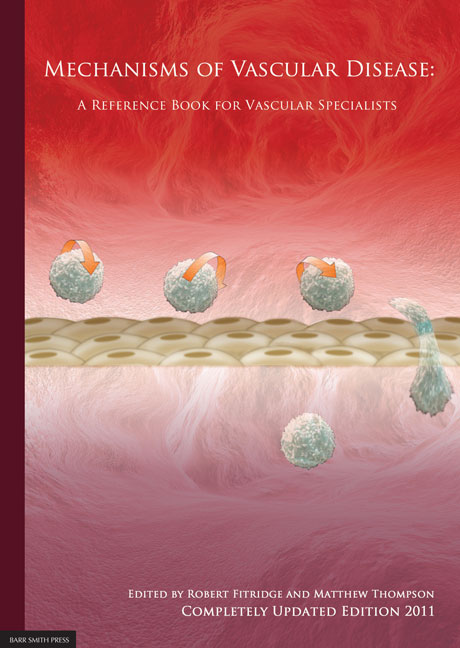Book contents
- Frontmatter
- Contents
- List of Contributors
- Detailed Contents
- Acknowledgements
- Abbreviation List
- 1 Endothelium
- 2 Vascular smooth muscle structure and function
- 3 Atherosclerosis
- 4 Mechanisms of plaque rupture
- 5 Current and emerging therapies in atheroprotection
- 6 Molecular approaches to revascularisation in peripheral vascular disease
- 7 Biology of restenosis and targets for intervention
- 8 Vascular arterial haemodynamics
- 9 Physiological Haemostasis
- 10 Hypercoagulable States
- 11 Platelets in the pathogenesis of vascular disease and their role as a therapeutic target
- 12 Pathogenesis of aortic aneurysms
- 13 Pharmacological treatment of aneurysms
- 14 Pathophysiology of Aortic dissection and connective tissue disorders
- 15 Biomarkers in vascular disease
- 16 Pathophysiology and principles of management of vasculitis and Raynaud's phenomenon
- 17 SIRS, sepsis and multiorgan failure
- 18 Pathophysiology of reperfusion injury
- 19 Compartment syndromes
- 20 Pathophysiology of pain
- 21 Post-amputation pain
- 22 Treatment of neuropathic pain
- 23 Principles of wound healing
- 24 Pathophysiology and principles of varicose veins
- 25 Chronic venous insufficiency and leg ulceration: Principles and vascular biology
- 26 Pathophysiology and principles of management of the diabetic foot
- 27 Lymphoedema – Principles, genetics and pathophysiology
- 28 Graft materials past and future
- 29 Pathophysiology of vascular graft infections
- Index
16 - Pathophysiology and principles of management of vasculitis and Raynaud's phenomenon
Published online by Cambridge University Press: 05 June 2012
- Frontmatter
- Contents
- List of Contributors
- Detailed Contents
- Acknowledgements
- Abbreviation List
- 1 Endothelium
- 2 Vascular smooth muscle structure and function
- 3 Atherosclerosis
- 4 Mechanisms of plaque rupture
- 5 Current and emerging therapies in atheroprotection
- 6 Molecular approaches to revascularisation in peripheral vascular disease
- 7 Biology of restenosis and targets for intervention
- 8 Vascular arterial haemodynamics
- 9 Physiological Haemostasis
- 10 Hypercoagulable States
- 11 Platelets in the pathogenesis of vascular disease and their role as a therapeutic target
- 12 Pathogenesis of aortic aneurysms
- 13 Pharmacological treatment of aneurysms
- 14 Pathophysiology of Aortic dissection and connective tissue disorders
- 15 Biomarkers in vascular disease
- 16 Pathophysiology and principles of management of vasculitis and Raynaud's phenomenon
- 17 SIRS, sepsis and multiorgan failure
- 18 Pathophysiology of reperfusion injury
- 19 Compartment syndromes
- 20 Pathophysiology of pain
- 21 Post-amputation pain
- 22 Treatment of neuropathic pain
- 23 Principles of wound healing
- 24 Pathophysiology and principles of varicose veins
- 25 Chronic venous insufficiency and leg ulceration: Principles and vascular biology
- 26 Pathophysiology and principles of management of the diabetic foot
- 27 Lymphoedema – Principles, genetics and pathophysiology
- 28 Graft materials past and future
- 29 Pathophysiology of vascular graft infections
- Index
Summary
VASCULITIDES
Occlusive arterial lesions in humans are usually caused by atherosclerosis. The primary and secondary vasculitides are rare inflammatory conditions that may also cause such ischaemia as well as occasional aneurysms. These pathologies usually present with unusual manifestations of ischaemia, but may also be the cause of common symptoms such as stroke, hypertension, intermittent claudication or Raynaud's phenomenon. Delayed recognition of these diseases is often associated with severe and irreversible complications. While the vasculitides are usually managed by physicians, vascular surgeons should be able to recognise them and assist in their management when appropriate.
INTRODUCTION
The vasculitides consist of primary and secondary pathologies in which non-specific transmural inflammation occurs within a blood vessel. The consequent vascular injury can cause vessel disruption, aneurysm formation or occlusion which can affect any blood vessel. The pathogenesis of each of these diseases is unclear, although they generally fall into one of the following groups:
Immune complex vasculitides: These are induced by circulating immune complexes or histamine. This results in the activation of the complement system, cytocines and monocytes in the vessel wall.
Pauci-immune vasculitides: The anti-neutrophil cytoplasmic antibodies (ANCA) were first described in conjunction with rapidly progressing glomerulonephritis. Cytoplasmic ANCA (c-ANCA), perinuclear ANCA (p-ANCA) and x-ANCA (which is found in chronic inflammatory GIT pathologies) have been described. In the pauci-immune vasculitides, activation of neutrophils results in vascular endothelial damage.
T-cell vasculitides: In these, vessel wall damage is caused by cd4 lymphocyte mediated immune reactions.
- Type
- Chapter
- Information
- Mechanisms of Vascular DiseaseA Reference Book for Vascular Specialists, pp. 295 - 314Publisher: The University of Adelaide PressPrint publication year: 2011

